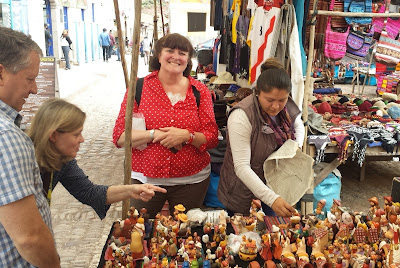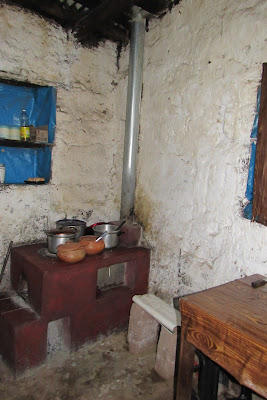On the third day of our trip, which happened to be Easter Sunday, we departed to the Lima airport at 6:30am to take a flight to the city of Cusco, which is the nearest airport to Machu Picchu.
I didn't have a window seat, but the lady sitting next to me was willing to let me lean over her and get some pictures out the window of the airplane.This was my first view of the Andes Mountains as we flew over them.
This is the city of Cusco, the 7th largest city in Peru.
These coca (from which cocaine is made) leaves were available at the airport for free. People chewed them for more energy, but Kent and I never tried them.
This was a scene out the window of the bus as we drove into the mountains to our first stop,which was a village of people with Incan blood in an area called the "Sacred Valley". They were in their native costumes.
As we came off the bus they sprinkled our heads with flower petals,
and then grabbed us to start dancing with them.
There was a llama, of course.
They lined up so we could pose for pictures with them,
then they served us lunch. I didn't get a picture of the first course, which was quinoa soup. These were the vegetables and cheeses they served us.
It's guinea pig. Kent and I tasted it, but the piece was so small and had so many bones I wasn't able to form a real impression of the flavor.
This was our main course, with chicken on the top right, guinea pig below it, and the veggies on the left.
After our meal they took us outside to show us a fabric weaving and dying demonstration.
We were shown some of the different llama and sheep fibers used in weaving,
These were some of the native crops--different types of potatoes and corn. Our tour guide claimed that in Peru there were 4,000 varieties of potatoes and 1,000 varieties of corn.
I didn't have many pictures of the men, so wanted to show their costumes.
We next drove to our resort, with vistas like this, and the photo below, out the bus windows.
.
That night we had dinner in a restaurant, and these men were playing live music on native Peruvian instruments. Kent posed with them after our meal.
As we were travelling we saw many figures like the ones above on the tops of most of the houses. I think they were for prosperity and good fortune for the home.
Our next stop were the ruins of a massive Incan fortress called Ollantaytambo.We climbed about 300 steps up to the top.
This was the view from the top.
Here are some examples of the extraordinary stone work we saw at all of the Incan ruins.
It's a mystery how they were able to cut the stone so exactly that no mortar was needed.
Afterwards we drove to a town and had some time to shop.
The town had these painted native costumes for the tourists, so we tried them out.
We looked pretty short!
Next stop were the ruins at Pisaq.
These were the dwelling places built into the sides of the hills.
These were some incredible terraces cut into the sides of the mountains.
I added the above picture to give perspective of how big the terraces are. In the bottom left corner of the photo are some people walking along them.
This native man was playing his flute for the tourists, and the music floated over the valley.
This church from the Spanish era was on the property of the resort.
That night we had a cultural exchange dinner with a local couple.
This was the entrance into the courtyard,They served us at a table that was open to the courtyard.
We went with other members of our tour group. We had a nice but simple meal that included rice, potatoes and chicken.
The dish above was corn kernels that had been roasted--tasted kind of like very crunchy corn nuts.
This picture shows the large size of the corn kernels, which is typical of the Peruvian corn. We were served the fruit, but I can't remember what it was called.
After dinner our hostess showed us her small and humble kitchen. The sink for washing dishes wasn't in the kitchen, but out in the courtyard. (which can be seen behind Kent in the first picture of us with the host couple.)
The most shocking sight in the kitchen was her pen full of guinea pigs!! I guess the Peruvian women know how to kill and skin the animals when they want to prepare it for a meal.















































No comments:
Post a Comment